Wednesday, November 9th 2011

All's Well That Haswell?
Here are the first slides detailing Haswell, Intel's next generation processor architecture that succeeds Sandy Bridge and Ivy Bridge. Intel follows a "tick-tock" product development model. Every year, Intel's product lineup sees either of the two. A "tock" brings in a new x86 architecture, a "tick" miniaturizes it to a newer silicon fabrication process. For example, Sandy Bridge is Intel's latest architecture, and is based on the 32 nm fab process. Ivy Bridge is a miniaturization of Sandy Bridge to 22 nm. Likewise, Haswell will be a brand new architecture, it will use the 22 nm fab process cemented by Ivy Bridge.
If all goes well with Intel's 22 nm process, Haswell is scheduled for Q2 2013. 2012 (Q2 onwards) will be led by Ivy Bridge. But then here's a "shocker": Haswell's desktop version will use a brand new socket, LGA1150, and will be incompatible with LGA1155. This is because of drastic changes in the pin map of the package. Sandy Bridge and Ivy Bridge share the LGA1155 socket, and will hence, have kept the socket alive for over 2 years. A major change with the component arrangement in the platform that is affecting Haswell's pin map is that Haswell will have a higher bandwidth chipset bus, rearranged PCIe pins (with FDI pins), rearranged power pins, and miscellaneous pins. It does away with a separate power domain for the integrated graphics controller.Haswell will bring several new features to the table, including next-generation RapidStart quick boot capabilities that reduce cold-boot times to 2 seconds. The processor's IPC will be increased over Ivy Bridge. The mobile version will include features that will further increase battery life of mainstream notebooks. Haswell will feature improved media HD to HD transcoding capabilities. It will bring technologies such as NFC (near-field communication), and Thunderbolt (10 Gbps interconnect) to the masses.
Moving on to the platform itself, it is named "Shark Bay", and will be available in 2-chip quad-core and 1-chip dual-core variants. The quad-core chips and some dual-core chips will use the usual socketed motherboards with a single-chip chipset (PCH) which is smaller than today's PCH chips, while the some dual-core chips will completely integrate the PCH into the processor's package, eliminating an external chipset. The dual-core chips will be available in BGA packages.
Source:
ChipHell
If all goes well with Intel's 22 nm process, Haswell is scheduled for Q2 2013. 2012 (Q2 onwards) will be led by Ivy Bridge. But then here's a "shocker": Haswell's desktop version will use a brand new socket, LGA1150, and will be incompatible with LGA1155. This is because of drastic changes in the pin map of the package. Sandy Bridge and Ivy Bridge share the LGA1155 socket, and will hence, have kept the socket alive for over 2 years. A major change with the component arrangement in the platform that is affecting Haswell's pin map is that Haswell will have a higher bandwidth chipset bus, rearranged PCIe pins (with FDI pins), rearranged power pins, and miscellaneous pins. It does away with a separate power domain for the integrated graphics controller.Haswell will bring several new features to the table, including next-generation RapidStart quick boot capabilities that reduce cold-boot times to 2 seconds. The processor's IPC will be increased over Ivy Bridge. The mobile version will include features that will further increase battery life of mainstream notebooks. Haswell will feature improved media HD to HD transcoding capabilities. It will bring technologies such as NFC (near-field communication), and Thunderbolt (10 Gbps interconnect) to the masses.
Moving on to the platform itself, it is named "Shark Bay", and will be available in 2-chip quad-core and 1-chip dual-core variants. The quad-core chips and some dual-core chips will use the usual socketed motherboards with a single-chip chipset (PCH) which is smaller than today's PCH chips, while the some dual-core chips will completely integrate the PCH into the processor's package, eliminating an external chipset. The dual-core chips will be available in BGA packages.
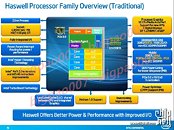
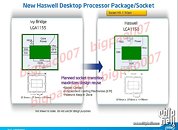
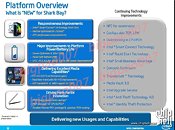
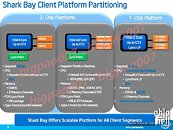
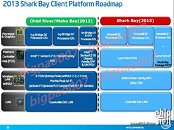
69 Comments on All's Well That Haswell?
I think people should be asking the question why did we loose 5 pins? It seems backwards to get less pins, but this may mean they have made it more efficient.
But, yeah, agree with you in principle. Most people upgrade their motherboard when they upgrade their processor(most upgrade the whole damn computer). And the enthusiasts are probably the select few that upgrade processors alone.
I'm at least happy that they have left Ivy Bridge on the same socket, unlike the 1156 users(like myself) that saw one generation of high end processor and that was it.
And for anyone that wants a reasoning behind changing sockets when moving to new architectures, ask AMD. They themselves have commented on how they've had to make sacrifices to the product in order to maintain compatibility.
...at this rate, if I wait long enough, I will be able to recycle my s775 ;)
lynnefield 1156, brought no benefits to those who had already adopted tylserburg nehalem, and was a value choice for people who were still on an older platform. those who waited for 1155 sandy bridge architecture from 775 would have had the best performance - value ratio, upgrading to a value mainstream platform which outperformed the already two generations old tylersburg nehalem.
anyone upgrading to Sandy bridge-E (patsburg) who's using anything newer or faster then 775 or lynnefield platform is not going to be gaining value for money, as it would be too much a side-grade and a waste. but for someone who's still on a 1156 or 775 platform would benefit greatly even if it is considered an extreme platform.
of course, the more platform generations that release and the longer you can wait, the better the performance to value ratio gets, but you have to pick your platform type and architecture carefully.
It will be a while before something tops the lga1155/2600 performance to value ratio, but it will happen. It doesn't mean that other platforms are completely pointless, they may be so to anyone on anything that can perform well at the moment, but are still a vast improvement to anybody who's running a dated or slow platform.
purple monkey dishwasher!
1366 -> 2011
1156 -> 1155 -> 1150.
Those are two parallel product lines. 1366 isn't dead, it's waiting for replacement by 2011 this Monday.
For me, the 8 RAM slots, the PCI-E lanes, the style of Ocing AND the future upgrade path are all the reasons I am going 2011. I need the RAM (not going to pay for 8GB modules), I prefer the style of OCing, I like to have the option of having a lot of PCI-E lanes as I often go multi-GPU and I am interested in going RevoDrive, and I'd like to keep my setup for longer than the LGA 1155 would let me, I do not want to be limited to 4 cores in the future
1. Create an Architecture to an existing socket
2. Create an Architecture 1st and then create a socket to the Architecture.
AMD is doing the 1st and Intel is doing the 2nd. The 2nd way is better than first in most ways. It will give the developers full freedom, they can integrate whole ideas, no problems when offering new features and give them relatively lower complexity to develop both the processors and socket.
The extra PCI-E lanes don't really make any difference, especially not at PCI-E 3.0.
And the ability to adjust BCLK with that odd multiplier setup isn't really helping that much, especially with the sacrifice of the unlocked CPU multiplier. I'd take an unlocked CPU multiplier over a locked with an odd BCKL multipler setup anyday. I don't see why anyone would prefer the 2011 style of overclocking. Just having a straight unlocked multiplier is by far the best.
There are 1155 boards that offer up to 10 SATA ports already(and that is on a $160 board), if you need more than that you probably shouldn't be using onboard anyway.
Like I said, the only reason to go 2011 is if you really need 6-cores for something, but since most don't need 6 cores, I wouldn't recommend spending more money for a bunch of stuff that looks nice on paper, but gives no real world benefit to 99% of people looking to buy.
You're assuming performance on socket 2011 is going to be about the same as a socket 1155/ 2600k but I expect a good improvement around 30%.
The memory system is going to bring the biggest % of performance increase, not because its quad channel but because they doubled the memory bit bus from the CPU.
Its not going to be the same situation like dual channel vs triple channel where the memory bit bus stayed the same.
Socket 2011 has unlocked CPU multiplier AND unlocked bclk so they have both options and There will be a reasonably priced non-extreme CPU with unlocked multi.
Clock for clock, socket 2011 should be at least 30% faster than socket 1155, If its not, Intel wont sell many systems. They are targeting socket 1366 owners who still get good performance, so unless socket 2011 is good people will just stick with socket 1366 and new buyers will go with socket 1155.
I doubt very much that socket 2011 will be similar to socket 1155 performance.
If you are looking to keep this setup for a long time, PCI-E bandwidth may start to be a problem in the future... especially if you are thinking of multi-GPU + RevoDrive etc. Ans so far, I do not see many PCI-E 3.0 mobos, is SB even PCI-E 3.0 compatible or will it be a IB only feature?
As said, I was referring to BCLK + multiplier unlocked.
You don't have to need 6 cores right now, but in 3 years? Also, the 4-core should be the same price, and the only premium you would be paying is on the mobo. For the upgrade path and the quad-channel and the RAM slots and the PCI-E lanes and the slightly higher performance, I'll go SB-E
Perhaps the 2011 socket is probably not 30% faster, but it will stll be faster than SB for sure, probably enough to make some kind of difference
I was thrown off by that newegg price lol
I wonder what Microcenter will be selling it for xD